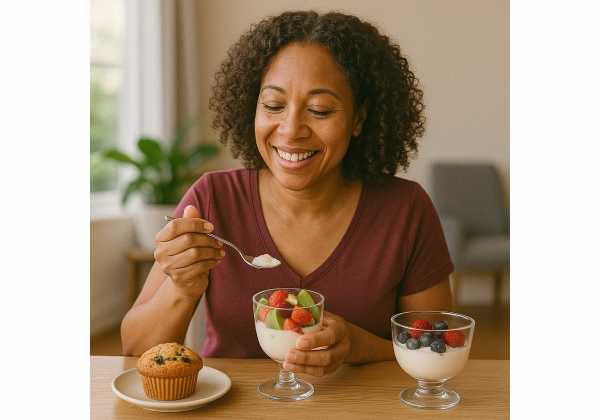
A good dessert can be part of a long-lived life. The goal is not to outlaw sweetness but to shape it: more protein and fiber, slower glucose rise, fewer cravings later. As metabolism shifts with age, many people notice steeper post-meal glucose peaks, lighter sleep after sugary nights, and hunger rebound the next morning. Small upgrades—a protein base, viscous fiber, and well-timed portions—turn dessert into a steady finish rather than a roller coaster. This article offers principles, portion guides, and rapid ideas you can use right away, whether you cook at home or order out. If you want a broader context for how desserts fit into a longevity-focused pattern, explore our longevity nutrition framework that emphasizes pattern, protein, and polyphenols.
Table of Contents
- Principles for Dessert: Protein, Fiber, and Smart Fat
- Sweetener Options: Pros, Cons, and Tolerance
- Portion Size, Timing, and Frequency That Work
- Fruit Forward Desserts and Chocolate Pairings
- Restaurant and Social Strategies You Can Use
- Five Fast Dessert Ideas Under Ten Minutes
- How to Reduce Sweetness Over Time without Feeling Deprived
Principles for Dessert: Protein, Fiber, and Smart Fat
Dessert can either calm or provoke your appetite for the next 12–24 hours. The difference usually comes down to three levers—protein, fiber, and fat quality—and how they shape gastric emptying, gut hormones, and blood glucose.
Lead with protein. A dessert that includes 15–25 g of protein often leaves you more satisfied and less likely to snack later. Practical anchors:
- ¾–1 cup skyr or Greek yogurt (15–20 g).
- 200 g low-fat cottage cheese (24–26 g).
- A scoop of whey, casein, or soy isolate (20–25 g) blended into a mousse or pudding.
- Silken tofu (150–200 g) blended with cocoa and berries (15–20 g).
Use fiber to slow the curve. Viscous and gel-forming fibers (psyllium, beta-glucan from oats, pectin in fruit) slow glucose entry. You can add 1–2 teaspoons of psyllium husk to yogurt parfaits, fold oat bran into fruit crumbles, or choose whole fruit instead of juice or syrup. Aim for 5–10 g of fiber in a dessert course if your gut tolerates it.
Choose “smart fats.” A little fat helps with satiety and flavor, but the type matters. Use extra-virgin olive oil in olive-oil citrus cakes; choose nuts (pistachios, walnuts, almonds) and seeds (chia, flax) in crumbles or crusts; add avocado to chocolate puddings. Keep portions modest—about 1–2 tablespoons of nut butter or 15–30 g of nuts.
Favor structure. Foods that require chewing and have intact cell walls (berries, apples, pears) blunt spikes more than liquids or finely milled flours. Build bowls with layers: strained yogurt → chia gel → berries → chopped nuts → dark chocolate shavings.
Dial sweetness down gradually. Most palates adapt within 2–4 weeks. If a recipe calls for 3 tablespoons of sugar or syrup, try 2 tablespoons now and 1½ next time. Use fruit for sweetness and acidity—ripe berries, mango cubes with lime, roasted pears with cinnamon—so less added sugar feels “complete.”
Time dessert on a fed stomach. Dessert right after dinner (when gastric emptying is slower) usually creates a smaller glucose excursion than dessert on an empty stomach.
Hydrate and mineralize. Many people confuse thirst with a “sweet tooth.” A glass of water or a cup of mint tea before dessert often reduces portion creep. A pinch of cocoa plus a few pistachios adds a little potassium and magnesium—useful for evening relaxation.
Build a template. Keep two go-to formats:
- Protein parfait: yogurt or cottage cheese + fruit + crunch + spice (cinnamon, cardamom) + optional cocoa.
- Fruit-nut plate: seasonal fruit + 15–20 g dark chocolate + 15–30 g nuts + a spoon of ricotta or labneh.
These principles let you enjoy dessert while keeping energy steady and sleep undisturbed.
Sweetener Options: Pros, Cons, and Tolerance
No single sweetener is perfect. The right choice depends on your goals (glucose control, weight, gut comfort), your taste, and how you use the sweetener in recipes. Here is a practical overview.
Sugars with calories
- Sucrose, brown sugar, coconut sugar, maple syrup, honey. Each offers a distinct flavor, but they are all mostly sucrose or fructose and raise blood glucose in varying degrees. Honey and maple are not “free passes.” If you use them, treat them like sugar and keep portions small.
- Fruit sugars. Whole fruit brings fiber, water, potassium, and polyphenols, which moderate spikes. Dried fruit removes water and concentrates sugar; use 1–2 tablespoons to garnish, not to sweeten the base.
Non-nutritive sweeteners (NNS)
- Stevia and monk fruit extracts (glycosides and mogrosides) are very sweet and heat-stable. They do not provide calories. Some find a bitter or licorice aftertaste; blending with a little sugar or erythritol reduces off-notes.
- Sucralose, acesulfame-K, aspartame. Potent and heat-stable (except aspartame at high heat). They can cut sugar substantially in baked goods. Tolerance varies; some people report headaches or GI discomfort at higher intakes.
- Sugar alcohols (erythritol, xylitol, maltitol): lower calories than sugar, but large amounts may cause gas or loose stools. Erythritol is the most gut-friendly for many; maltitol is the most likely to spike glucose and cause GI issues.
- Allulose. A rare sugar with ~0.4 kcal/g that browns well, tastes like sugar, and has minimal glucose impact for most people. High doses can loosen stools; most tolerate 5–15 g per serving.
How to choose
- If your main goal is to reduce post-meal glucose, blend a small amount of sugar with stevia or allulose to keep taste high while cutting glycemic load.
- If your main goal is weight control, remember that sweetness without calories may or may not reduce energy intake later. Pair NNS with an adequate protein portion so dessert still satisfies.
- If gut comfort is sensitive, test sugar alcohols slowly. Start with ½ teaspoon of erythritol (≈2 g) and titrate up.
Best uses in the kitchen
- Baking: Allulose or erythritol blend + a teaspoon of real sugar for browning and structure.
- Cold desserts: Stevia/monk fruit drops in yogurt, ricotta, or chia puddings.
- Hot drinks: A few drops of stevia or a teaspoon of honey—choose flavor first and keep the dose small.
For a deeper dive on ingredient trade-offs and practical swaps, see sweeteners and aging.
Portion Size, Timing, and Frequency That Work
Portion and timing matter as much as ingredients. These guidelines keep dessert enjoyable without nudging blood glucose, sleep, or appetite in the wrong direction.
Portion anchors
- Protein base: ¾–1 cup skyr, Greek yogurt, or cottage cheese; or 150–200 g silken tofu; or a scoop of protein powder (20–25 g protein) blended into pudding.
- Fruit: 1 cup berries; or 1 medium fruit (apple, pear, kiwi, orange); or ½ cup tropical fruit (mango, pineapple) when pairing with extra protein or viscous fiber.
- Chocolate and nuts: 15–20 g dark chocolate (70–85% cocoa) and 15–30 g nuts or 1 tablespoon nut butter.
- Added sugars: Keep added sweeteners to ≤1–2 teaspoons per serving. Many recipes taste “sweet enough” once you include ripe fruit and spices.
Timing guidance
- After dinner is safer than late-night grazing. Dessert within 60 minutes of a protein- and fiber-rich meal typically produces a gentler glucose rise than dessert alone.
- Before bed: If you prefer a small dessert 60–90 minutes before sleep, build it on a protein base with minimal added sugar (e.g., cottage cheese + cinnamon + berries). This structure supports muscle recovery and reduces next-morning hunger.
Frequency
- Most people do well with dessert 3–7 times per week when portions follow the anchors above. If weight or glucose targets are tight, start with 3–4 evenings.
Use activity to your advantage
- A 10–15 minute walk after dinner meaningfully flattens the post-meal curve in many people.
- On training days, dessert anchored by 20–30 g of protein can aid recovery and curb late-night nibbling.
Personalize with simple checks
- Track sleep quality and next-morning appetite. If you wake up extra hungry or sluggish, scale back added sugars and increase protein by 5–10 g.
- If you monitor glucose, compare your usual dessert to a protein-first version. Many see a 20–40 mg/dL lower peak with protein and viscous fiber on board.
Want broader guidance on when to place carbs and sweets across the day? See strategies in carb timing.
Fruit Forward Desserts and Chocolate Pairings
Fruit-based desserts deliver sweetness with fiber, water, potassium, vitamin C, and polyphenols. Selecting fruits with structure, pairing them with protein, and adding a little dark chocolate often hits both pleasure and physiology.
High-impact fruit choices
- Berries (strawberries, blueberries, raspberries, blackberries). Lower sugar per volume, high fiber and anthocyanins; excellent with yogurt or ricotta.
- Citrus (orange segments, grapefruit, clementines). Bright acidity reduces the need for added sugar; terrific in olive-oil cakes and panna cotta.
- Apples and pears. Pectin-rich; roast or sauté with cinnamon for a warm base under skyr or cottage cheese.
- Stone fruit (peaches, plums, cherries). Grill or roast to intensify flavor; pair with mascarpone lightened with yogurt.
- Kiwi and pineapple. Enzymes soften dairy; combine with Greek yogurt right before serving to preserve texture.
Build a fruit-forward plate
- Choose one fruit family (e.g., berries).
- Add protein (¾–1 cup skyr/cottage cheese, or a tofu-cocoa mousse).
- Layer crunch (10–15 g nuts or seeds).
- Finish with aroma (citrus zest, vanilla, cardamom) and a square of dark chocolate (15–20 g, 70–85% cocoa).
Chocolate done smart
- Choose higher-cocoa chocolate for more flavanols and less sugar per gram.
- Pair with fruit and nuts to slow absorption and improve satiety.
- Melt 15–20 g dark chocolate with 1 teaspoon olive oil; drizzle over citrus or berries for a glossy finish.
For more on benefits and smart uses of cocoa, see our practical guide to cocoa flavanols.
Restaurant and Social Strategies You Can Use
Celebrations and dining out should feel easy, not like a test. Use these moves to enjoy dessert and still feel great the next day.
Before you go
- Eat a protein-rich snack (e.g., ¾ cup skyr) if dinner will be late; you will order more calmly and split dessert more readily.
- Decide on your lane: split one dessert, order coffee/tea with fruit, or choose a single-serve option (e.g., gelato cup), and stick to it.
At the table
- Scan for structure. Fruit bowls, panna cottas, cheesecakes, and flourless tortes are easier to portion than towering layer cakes.
- Share by design. Ask for an extra spoon and split a single dessert for the table. You enjoy several flavors with smaller bites.
- Add protein. Request a side of plain yogurt, ricotta, or a cheese plate to pair with fruit desserts.
- Pace with your drink. Alternate bites with sips of unsweetened tea, espresso, or sparkling water. This slows eating without feeling restricted.
Portion tactics
- Two-thirds rule: Enjoy two-thirds, leave one-third. It trims sugar by 30% without hurting satisfaction.
- First and last bites. Take the first bite slowly and save a “best bite” for last. This reduces the urge to keep going for novelty.
After the meal
- Take a short, brisk walk (10–15 minutes). It acts like a “glycemic brake.”
- Bring leftovers home in a small container and pair them tomorrow with a protein base.
For more travel and dining tactics that keep your energy steady, visit smart eating out strategies.
Five Fast Dessert Ideas Under Ten Minutes
Speed and satisfaction can coexist. These five ideas average 15–25 g protein, 5–10 g fiber, and ≤10 g added sugar when portions match the notes.
- Greek Yogurt “Cheesecake” Bowl
- 1 cup plain Greek yogurt + 1 teaspoon honey or allulose + ½ teaspoon vanilla + zest of ½ lemon.
- Top with 1 cup blueberries and 2 tablespoons crushed walnuts.
- Macro guide: ~20 g protein, 6–8 g fiber.
- Cottage-Cocoa Cup
- ¾–1 cup cottage cheese blended with 1 tablespoon cocoa, a pinch of cinnamon, and optional ½ teaspoon allulose.
- Top with sliced strawberries and 1 teaspoon chopped dark chocolate.
- Macro guide: ~24 g protein, 3–5 g fiber.
- Tofu-Mocha Mousse
- Blend 200 g silken tofu with 1 tablespoon cocoa, ½ teaspoon instant espresso, ½ teaspoon vanilla, and 1–2 teaspoons allulose or 1 teaspoon maple syrup.
- Top with raspberries and cacao nibs.
- Macro guide: ~16–20 g protein, 6–8 g fiber.
- Chia-Ricotta Citrus Parfait
- Stir 1 tablespoon chia seeds into ½ cup milk (or soy), set 5 minutes.
- Layer with ½ cup ricotta whipped with orange zest and a few drops of stevia or 1 teaspoon sugar.
- Add segmented orange and pistachios.
- Macro guide: ~15–18 g protein, 8–10 g fiber.
- Warm Apple Skillet with Skyr
- Sauté 1 sliced apple in a teaspoon of olive oil or butter, add cinnamon and a splash of water; cover 3–4 minutes.
- Serve over ¾ cup skyr with 1 tablespoon oat bran and 1 teaspoon chopped dark chocolate.
- Macro guide: ~20 g protein, 7–9 g fiber.
Batch-friendly components—chia gel, roasted fruit, pre-portioned nuts—make fast desserts even faster. For more ways to prep ahead, see evening-friendly snacks that support sleep.
How to Reduce Sweetness Over Time without Feeling Deprived
Reducing sweetness is easier when you shift taste expectations and make small, steady changes. The aim is not to eliminate dessert but to recalibrate what “sweet enough” means for you.
Week 1–2: Change the base, not the flavor.
- Keep your favorite dessert format but swap in a protein base: yogurt, cottage cheese, or tofu mousse instead of ice cream; fruit-nut plates instead of pastries.
- Cut added sweetener by 25–33% and replace with fragrant elements: citrus zest, vanilla, cardamom, cinnamon, or espresso powder.
Week 3–4: Add structure and crunch.
- Introduce chew—chopped nuts, cacao nibs, toasted oat bran, or coconut flakes—to slow eating and enhance satisfaction.
- Use fruit forward constructions: roasted pears with cinnamon; berries with ricotta and dark chocolate shavings. Flavor intensity lets you trim sugar further.
Week 5–6: Shrink portions, keep ritual.
- Move to smaller bowls/plates and pre-portion chocolate (15–20 g pieces).
- Practice the two-thirds rule at restaurants and split desserts at social events.
Fine-tune with feedback loops
- Keep a short note in your phone: dessert type, time, sleep quality, and next-morning hunger. Patterns usually appear within 2–3 weeks.
- If evenings trigger cravings, increase dinner protein by 5–10 g and add 5 g viscous fiber (e.g., 1 teaspoon psyllium in yogurt) to dessert.
Build a “sweet scale”
- On a 1–10 scale, rate how sweet your dessert tastes. Aim to step down one point every 1–2 weeks. Most people settle at 4–5—pleasantly sweet without a crash.
Celebrate progress
- Notice wins: calmer sleep, steadier mornings, clothes fitting better, and genuine enjoyment of subtler flavors. That feedback loop sustains change.
References
- Use of non-sugar sweeteners: WHO guideline 2023 (Guideline)
- Effects of non-nutritive sweeteners on body weight: a systematic review and meta-analysis of randomized controlled trial (RCT) studies 2025 (Systematic Review)
- Acute intake of purified cocoa flavanols improves vascular endothelial function in adults with cardiovascular disease: A systematic review and meta-analysis of randomized human trials 2024 (Systematic Review)
- Effect of viscous soluble dietary fiber on glucose and lipid metabolism in patients with type 2 diabetes mellitus: a systematic review and meta-analysis on randomized clinical trials 2023 (Systematic Review)
- Pre-Sleep Casein Supplementation, Metabolism, and Appetite: A Critical Review 2021 (Systematic Review)
Disclaimer
The information in this article is educational and is not a substitute for personalized medical advice. Nutrition needs vary with medical conditions, medications, laboratory results, and personal goals. Consult your physician or a registered dietitian before making significant dietary changes, especially if you have diabetes, kidney disease, gastrointestinal disorders, or food allergies.
If you found this guide useful, please consider sharing it with a friend or on Facebook, X (formerly Twitter), or your preferred platform, and follow us for future articles. Your support helps us continue creating clear, practical resources on healthy aging.










